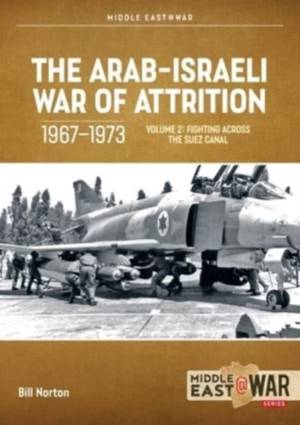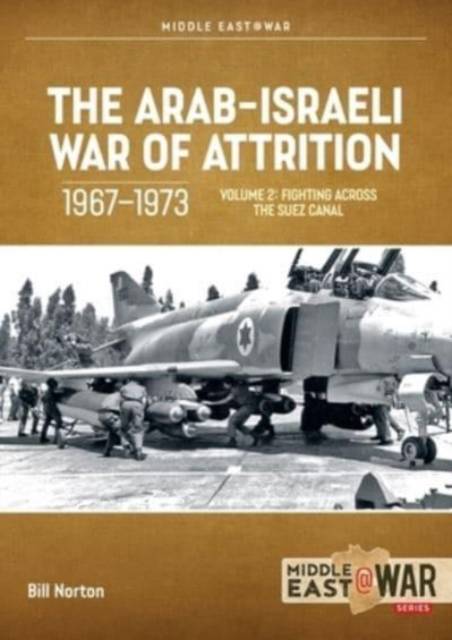
- Retrait gratuit dans votre magasin Club
- 7.000.000 titres dans notre catalogue
- Payer en toute sécurité
- Toujours un magasin près de chez vous
- Retrait gratuit dans votre magasin Club
- 7.000.0000 titres dans notre catalogue
- Payer en toute sécurité
- Toujours un magasin près de chez vous
27,95 €
+ 55 points
Format
Description
The Arab-Israeli conflict persisted through two wars and ongoing border tensions. However, the Six-Day War of June 1967 was a cataclysm. Israel emerged victorious in a war with neighboring Arab states and in possession of occupied territory. The Arabs were furious at this outcome and determined to regain their lands and dignity by again making war with Israel. Added to the mix was a resurgent Palestinian liberation movement. Renewed fighting began within weeks. It became a period of sustained combat, casualties, fiscal outlay, and diplomacy on the world stage unlike anything experienced previously. All involved militaries remained very active over these years with more consistent mobilization, intensive training, and action than ever before. Each side deepened their dependence on superpower arms supply. The geopolitical stakes rose and Israel found itself fighting the Soviets indirectly on the borders and terrorists internationally. Adversary forces grew in size, adopted more complex weapons, and trained in new tactics, all in the tumult of combat of escalating intensity. The air forces of especially Israel and Egypt, then Syria, became particularly active, grew in size and capabilities. They employed some of the most advanced weapons the USA and the USSR arrayed in their Cold War confrontation. The air war grew to extensive air defenses and long-range bombing plus deep photo reconnaissance. The danger of this sparking another general war with potential superpower involvement was high. This period is collectively referred to as the War of Attrition.
The named War of Attrition on the Suez Canal began on 8 March 1969 and ended with a ceasefire 17 months later. However, combat began even before this period. Egypt built up forces opposite the canal to harass the Israelis and in preparation for an offensive to liberate the Sinai Peninsula. The harassment included heavy shelling, airstrikes, and commando raids. Israel became even more determined to hold the line on the canal east bank and built a string of fortifications supporting this strategy and expanded available forces. Protecting these assets required responding artillery fire and bold commando raids until Israel felt compelled to unleash its air force. Bombing and air-to-air combat grew in intensity and eventually extended to the Egyptian heartland. The Soviet Union assisted Egypt materially until finally intervening with an air defense division consisting of the latest surface-to-air missiles and fighters, operated by USSR combat personnel. Undaunted, Israel fought on in a continuing and dangerous escalation. Both sides approach exhaustion before a ceasefire was arranged.
It was an extraordinary time of confrontation, irregular warfare, rising terrorism, and national struggles seldom seen before or since. It became the world's most violent, costly, and dangerous conflict after that in Southeast Asia. At the center of it, Israel found herself engaged on all sides and isolated as never before. The struggle altered the geopolitical landscape and set the stage for the October 1973 war.
Volume 2 focuses on the fighting across the Suez Canal in a manner never before presented in print. Richly illustrated with photographs, maps, charts and tables, the reader will find new details and correction of previously published 'facts.' This is the most focused and clear account of the fighting on the Suez Canal during 1968-1970.
The named War of Attrition on the Suez Canal began on 8 March 1969 and ended with a ceasefire 17 months later. However, combat began even before this period. Egypt built up forces opposite the canal to harass the Israelis and in preparation for an offensive to liberate the Sinai Peninsula. The harassment included heavy shelling, airstrikes, and commando raids. Israel became even more determined to hold the line on the canal east bank and built a string of fortifications supporting this strategy and expanded available forces. Protecting these assets required responding artillery fire and bold commando raids until Israel felt compelled to unleash its air force. Bombing and air-to-air combat grew in intensity and eventually extended to the Egyptian heartland. The Soviet Union assisted Egypt materially until finally intervening with an air defense division consisting of the latest surface-to-air missiles and fighters, operated by USSR combat personnel. Undaunted, Israel fought on in a continuing and dangerous escalation. Both sides approach exhaustion before a ceasefire was arranged.
It was an extraordinary time of confrontation, irregular warfare, rising terrorism, and national struggles seldom seen before or since. It became the world's most violent, costly, and dangerous conflict after that in Southeast Asia. At the center of it, Israel found herself engaged on all sides and isolated as never before. The struggle altered the geopolitical landscape and set the stage for the October 1973 war.
Volume 2 focuses on the fighting across the Suez Canal in a manner never before presented in print. Richly illustrated with photographs, maps, charts and tables, the reader will find new details and correction of previously published 'facts.' This is the most focused and clear account of the fighting on the Suez Canal during 1968-1970.
Spécifications
Parties prenantes
- Auteur(s) :
- Editeur:
Contenu
- Nombre de pages :
- 94
- Langue:
- Anglais
- Collection :
Caractéristiques
- EAN:
- 9781804512265
- Date de parution :
- 03-08-23
- Format:
- Livre broché
- Format numérique:
- Trade paperback (VS)
- Dimensions :
- 216 mm x 287 mm
- Poids :
- 521 g

Les avis
Nous publions uniquement les avis qui respectent les conditions requises. Consultez nos conditions pour les avis.






